"S-Posture" vs. Low Back
Pain
 
Previous issue was
about Upper-Cross Syndrome. This month's topic will be about Lower-Cross
Syndrome. What are
Upper and Lower Cross Syndrome? They are syndromes with various complications
that can wreak havoc on the average person. For the athlete, especially the
powerlifter, they can decrease strength, flexibility, range of motion and lead
to further degenerative processes (wearing down of the body - arthritis, etc.).
Upper cross syndrome refers to the upper part of the body, namely the neck /
upper back / chest / shoulder areas. Lower cross syndrome refers to the lower
part of the body surrounding the pelvis / lower back / abdominal / upper thigh
areas.
What
happens in both syndromes is that several muscle groups have become shorter and
tighter. Other muscle groups have become weakened as a result of the previous
mentioned tight muscles. What happens then is these problem areas start a bad
cycle - they each get worse, making the other worse also. More tight muscles and
increased weak muscles. Unless they are halted, they will start to change the
composition and integrity of the surrounding joints, muscles, cartilage, nervous
structures and other tissues. This means osteoarthritis (aging or degenerative
arthritis) can rear its ugly head. This is not good for the powerlifter as the
powerlifter needs good joints to withstand the incredible stresses and forces we
place on them during our heavy training. Postural changes of the body will also
occur with these syndromes.
The Lower Crossed Syndrome ("S-Posture")
Lower cross
syndrome consists of various tightened and weak muscles. The tight muscles are
generally as follows: hip flexors (such asiIliopsoas, rectus femoris - one of
the quadricep muscles), and erector spinae muscle group - the muscles on either
side of the spine. The weakened muscles are as follows: abdominal muscles and
gluteus maximus - part of your buttock muscles. How do you know if you have
lower cross syndrome? Having a swayback (excessive curve of the lower back) is a
good indication of lower cross syndrome. Demostrating an anterior pelvic tilt
(hips tilted forward), increased lumbar (low back) lordosis (curve) and
increased hip flexion. Lower back pain can suggest lower cross syndrome is
involved, however, there are also many causes of low back pain.
What can
you do if you have Lower Cross Syndrome? Identifying the problem areas is
important. Next, stretching and lengthening the tightened muscles is very
important as is strengthening the weakened muscles. You will not see immediate
results in doing the above. The athlete needs to be consistent with the above
regimen, just as it takes hard and consistent training to get strong. It will
not happen overnight. If you do the above over a three to six month period, you
will start to see changes to these problem areas. After you notice changes
happening, continue to do these exercises and you will become stronger as the
muscles are able to work more synergistically (together) and decrease the
chances of degenerative processes from wreaking havoc on your body and making
you weaker. |
|
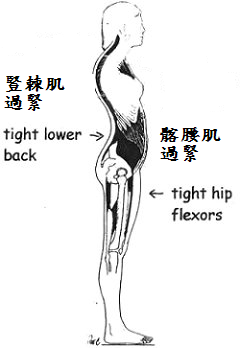
Lower-Cross Syndrome
Tight muscle:
hip flexors and erector spinae
Weakened muscle:
abdominal and gluteus maxinus |
Suggestions:
Half Boat Pose (Ardha
Navasana)
-- to strengthen
abdominal muscles group, including rectus abdominis, external oblique, internal
oblique and transversus abdominis. In which the transvesus abdominis is the
deepest muscle of the abdominal with fibres run horiontally acts like an
internal weight belt, to stablize lumbar spine and assisting in normal lordosis
maintenance.
1. Sit on the floor
with the legs in front of you. Interlock the fingers behind your head.
2. Lean back and let
your lower back on the floor. As
you exhale, lift your legs off the mat. Keep your knees
straight and your legs together. Keep your toes
and your eyes in the same line.
3. Keep breathing
and hold for at least 30 seconds.
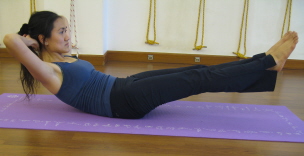
Four
Limbs Staff Pose (Chaturanga
Dandasana)
-- to
strengthen
abdominal, back
and buttock muscles.
1. From
Plank position, firm the abdomen and bend the arms straight back, keeping the
upper arms hugging into your sides.
2. As
you exhale, lower down toward the floor, stopping when your forearms and
upper arms are at a right angle.
3. Keep
the whole body level with the floor.
4. Push
back into the heels.
5. Keep
breathing and hold for 5 seconds. 2 times a day. Gradually increase to hold this
pose for 45 seconds.
6. Lastly,
exhale and lower the body to the floor and rest.
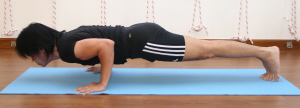
Bridge Pose
(Setubandha
Sarvangasana)
-- to
strengthen
buttock muscles
1. Lie supine on the
floor, arms by the sides of the body. Bend your knees and set your feet on the
floor, heels as close to the sitting bones as possible.
2. Exhale and,
pressing your inner feet and arms actively into the floor, push your tailbone
upward toward the pubis, and lift the buttocks off the floor. Keep your thighs
and inner feet parallel.
3. Keep your knees
directly over the heels, but push them forward, away from the hips, and lengthen
the tailbone toward the backs of the knees. Lift the pubis toward the navel.
4. Firming the shoulder
blades against your back, press the top of the sternum toward the chin. Stay on
the tops of your shoulders.
5. Stay in the pose
anywhere from 30 seconds to 1 minute with normal breathing. Release with an
exhalation, rolling the spine slowly down onto the floor.
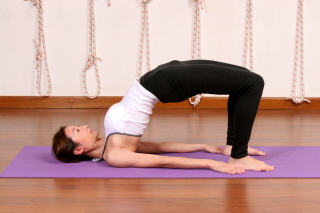
Modified
Pigeon Pose
(Kapotasana) --
to stretch hip flexors
-
Bend left knee and place the
sole and heel of the left foot flat on the floor, left knee over the left ankle.
-
Take the right leg back and bend
knee and place it on a blanket, right shin and right foot on the wall. The shin
of the right leg will then be vertical with the floor.
-
Place the finger tips on the
floor beside front foot. You will feel a stretch from the hips to your back
thigh.
-
Keep breathing and hold from 15
to 30 seconds. Repeat this pose on the other side.
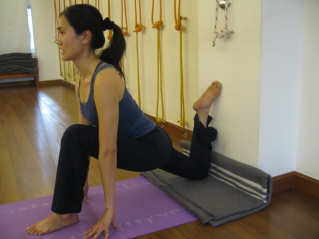
Tortoise Pose
(Kurmasana) --
to stretch erector
spinae
-
Sit on the mat with the legs
stretched straight in front. Widen the legs until the distance between two knees
is just slightly widen your shoulders.
-
Bend the knees and lift them up
by drawing the feet towards the trunk.
-
Exhale, bend from the hips and
extend the trunk forward. Insert the hands one by one under the knees, until the
upper arms underneath the knees and stretch them straight out sideways.
-
Bring the forehead, then the
chin and lastly the chest down to the floor. The Knees will then be near
the shoulders.
-
Keep breathing and hold this
position from 15 to 30 seconds.
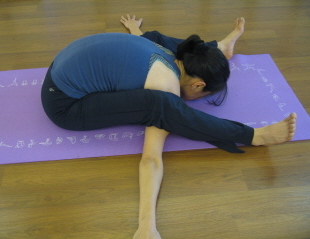
-
For experience people:Interlock
fingers at the back.

Head to
Knee Pose
(Janu Sirsasana)
-- to stretch back of
the thigh
-
Sit on the mat with legs
stretched straight in front of you.
-
Bend the left knee and move it
to the left, keeping the outer side of left thigh and the left calf on the
floor.
-
Extend the arms forward towards
the right foot and hold it with both hands.
-
Inhale, lift the chest
forward and extend the back of the body long,. Keeping the abdomen and back
long, exhale, move the trunk forward by bending the elbows to the side, the top
of head towards your top of the right foot.
-
Keep breathing and hold the pose
for 15-30 seconds. Inhale, return the the starting position, change to the other
side.

Namaste,
Kenny Choi and Josephine Yu
Back to Home Page
返回主頁
|


